Reviews
Beyond Banksy: This Massive LA Exhibition Dramatically Expands the Story of Graffiti
The Roger Gastman-curated "Beyond the Streets" trains a light on the studio work of famed street artists.
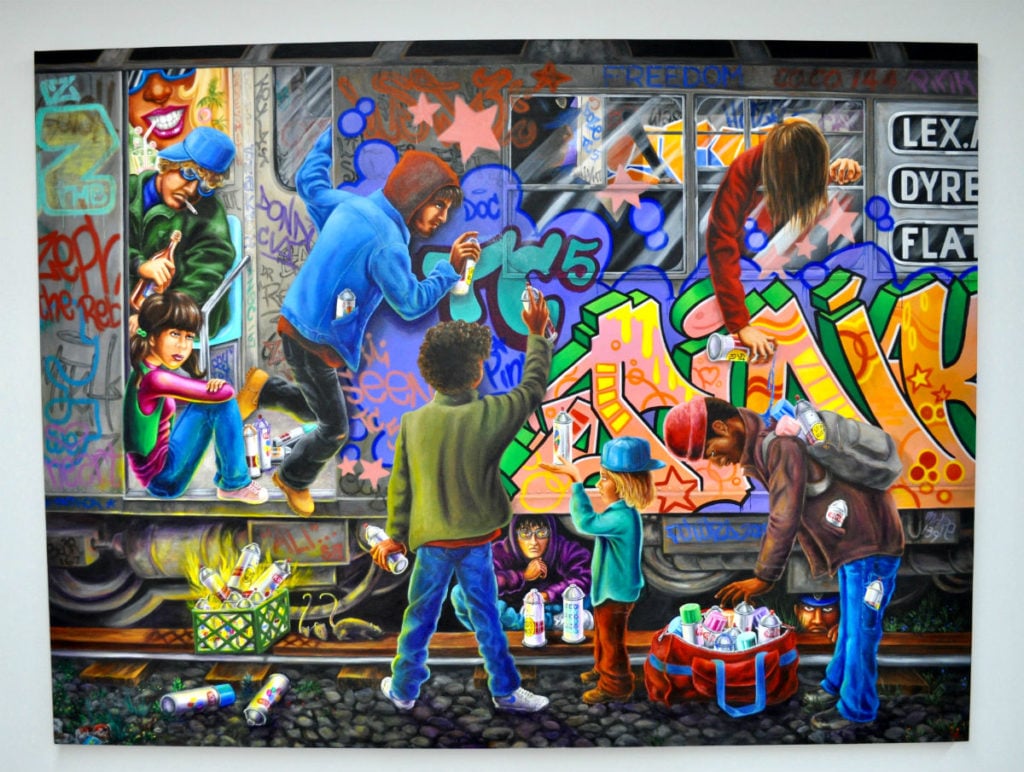
The Roger Gastman-curated "Beyond the Streets" trains a light on the studio work of famed street artists.

Colony Little

Walking through “Beyond the Streets,” the sprawling, adventurous show of diverse work by street artists housed in a 40,000-square-foot warehouse north of LA’s Chinatown, the opening scene of the seminal street art documentary Style Wars flickered into my mind. In it, a group of young New York graffiti artists stand in the street anxiously waiting for a subway train to pass on the elevated tracks above them. As cars emerge from their underground lairs freshly decorated with graffiti, the artists cheer for joy—a joy not shared by aggravated commuters as the spray-painted trains continue their slow journey across the city.
In its way, “Beyond the Streets,” curated by graffiti historian Roger Gastman, marks the arrival of that lumbering journey to a new destination, one where the venue has shifted along with the assumed reaction of the urban audience.
New York in the 1970s offered little hope for its youth. Bombing the trains afforded some of them a fleeting glimpse of fame as their masterpieces trudged along the tracks. For decades, graffiti and street art remained linked to vandalism, gang violence, crime, and blight, associations deliberately cultivated by municipalities, politicians, and the media, all of whom had their own reasons for making this urban art form a visual scapegoat for the societal ills of which it was merely a symptom.
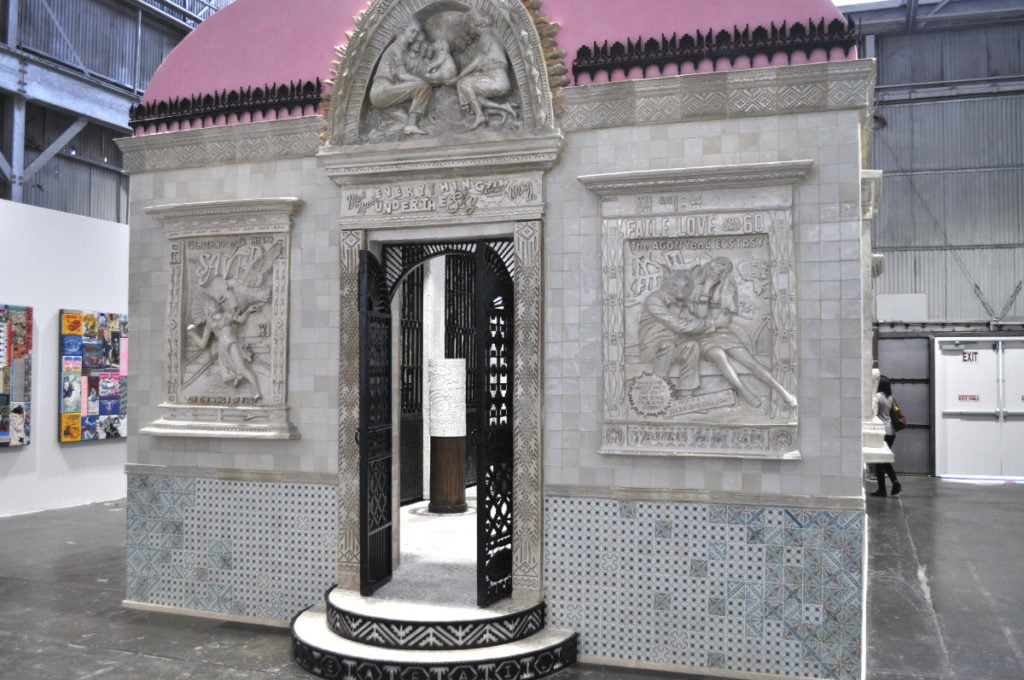
FAILE, Temple in “Beyond the Streets.” Image courtesy Colony Little.
This reductive view of street art ignored the root causes of New York’s economic and social challenges. But it also overlooked how the practices of graffiti and street art were evolving with the changing times, from tags to murals and publicly commissioned art.
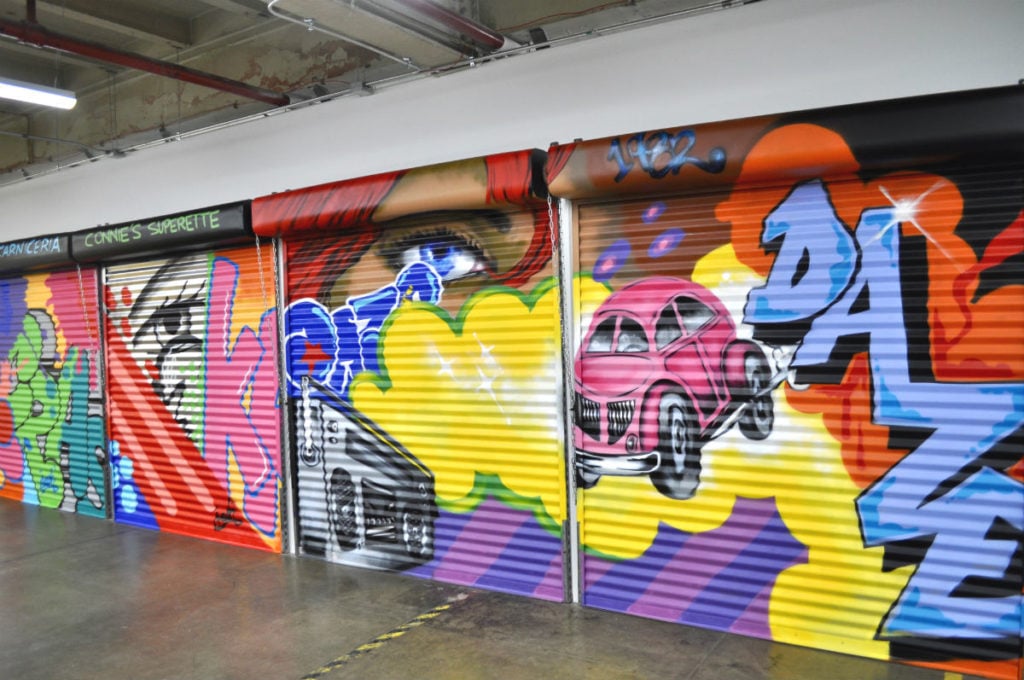
Mural by Daze in “Beyond the Streets.” Photo courtesy Colony Little.
Over the past 10 years, the conversation around street art has shifted, as a handful of its pioneers have achieved critical and commercial success and inspired a new cadre of young artists. In 2011, Gastman co-organized MOCA Los Angeles’s “Art in the Streets,” Jeffrey Deitch’s ambitious proof-of-concept exhibition whose goal was to firmly place street art under the umbrella of contemporary art.
With “Beyond the Streets,” Gastman expands this concept via a massive showcase of 100 artists, his warehouse venue giving him the scale and the latitude to bring together big names and a variety of mediums that run adjacent to street art.
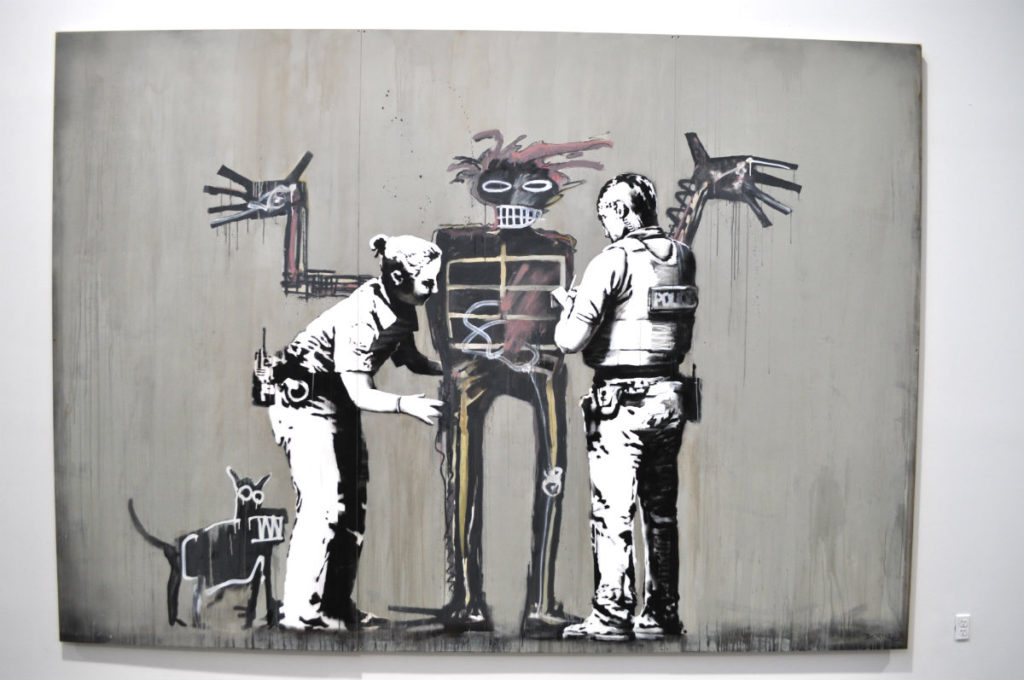
Banksy in “Beyond the Streets.” Photo courtesy Colony Little.
“Beyond the Streets” attempts to strip away the coded perceptions that lurk behind the most vehement detractors of graffiti. It reframes the movement, expanding its place within the canon of contemporary art. By curating it independently and in a warehouse, taking the medium out of the street and the gallery alike, Gastman places the studio work made by these street art and graffiti figures on neutral ground.
(Although unaffiliated with any particular institution, the show is presented with support from a variety of sponsors, including Adidas Skateboarding, Discover Los Angeles, Modernica, Montana Colors, NPR, and the Steel Partners Foundation.)
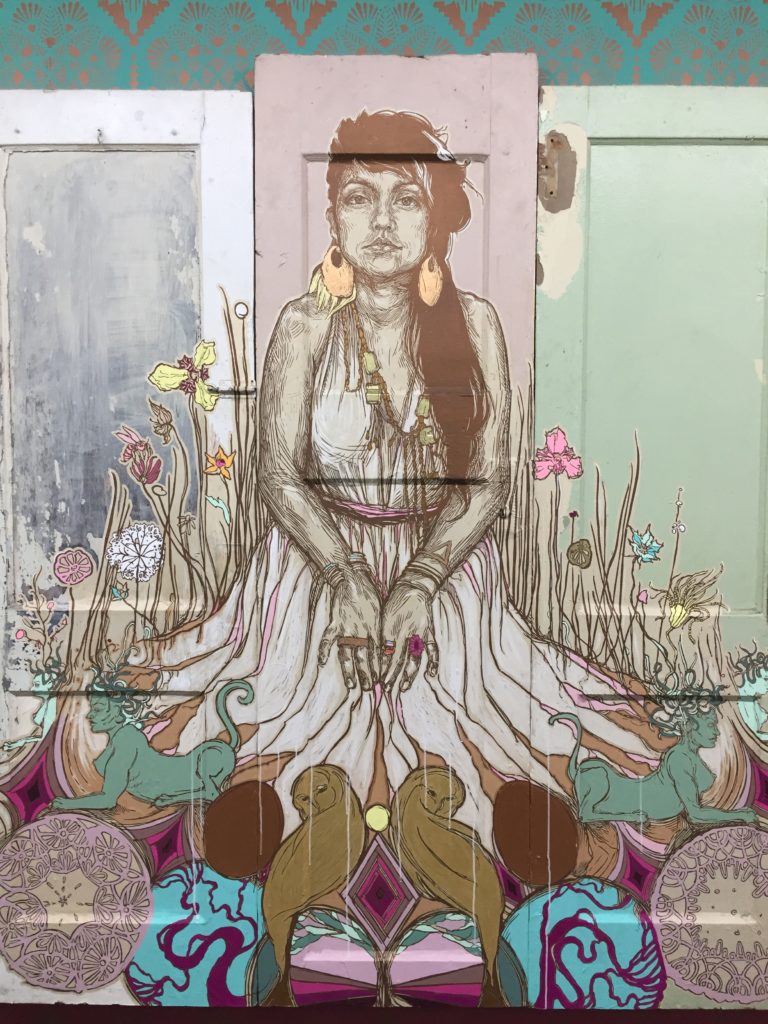
Work by Swoon in “Beyond the Streets.” Photo courtesy Colony Little.
Works by Swoon, Lady Pink, Basquiat, and Kenny Scharf mingle with large-scale installations by AIKO, Takashi Murakami, and FAILE, creating a kaleidoscope of visuals. Traditional murals, stencils, and sculpture are combined in unexpected installations that feature chapels, stripper poles, a temple, and an homage to a legendary Venice Beach skate park.
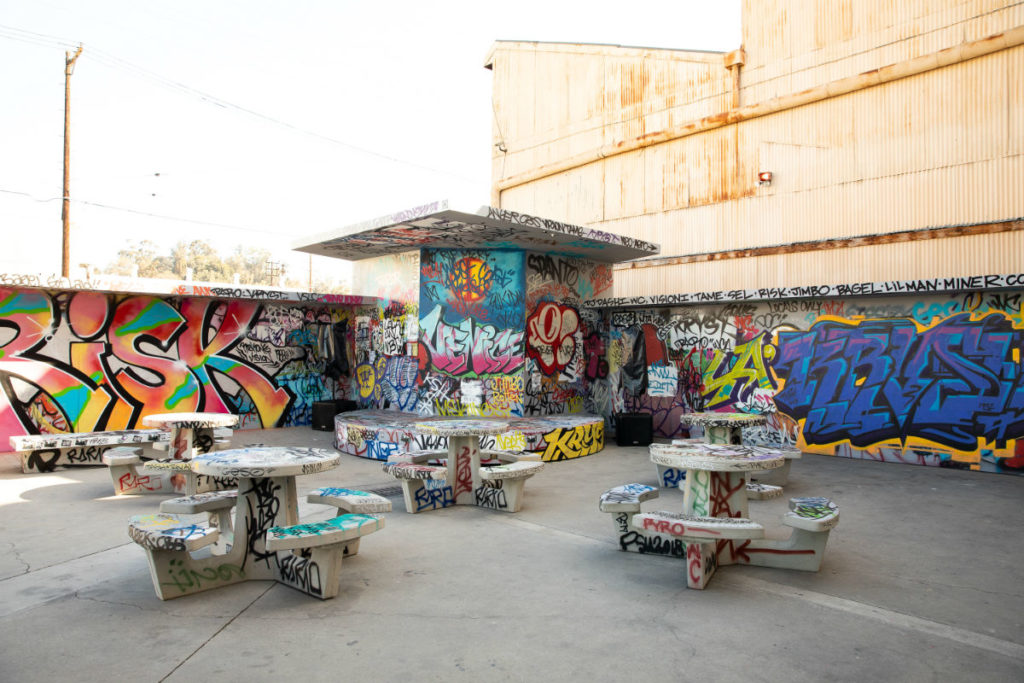
Recreation of Venice Beach’s Pavilion. Installation view in “Beyond the Streets.” Photo courtesy Beau Roulette.
To say that there’s something for everyone in “Beyond the Streets” is an understatement—however the show’s sensationalistic elements are smartly tempered with educational explorations into seminal moments in graffiti art’s history.
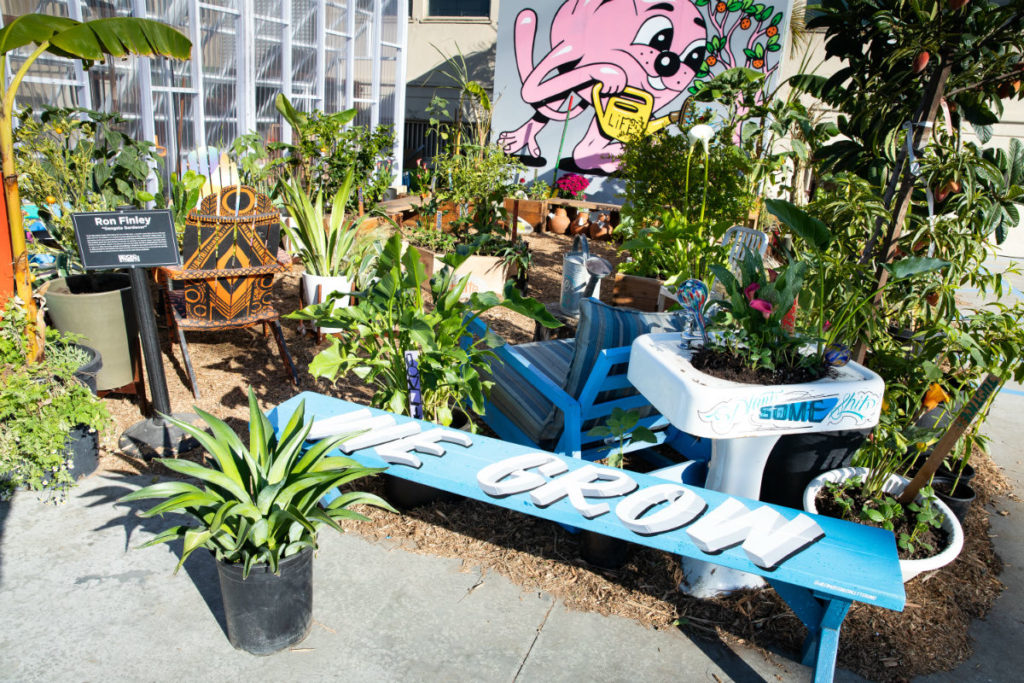
Ron Finley, Gangsta Garden (2018) in “Beyond the Streets.” Photo courtesy Beau Roulette.
Outside the entrance of the warehouse, “street gardener” Ron Finley displays his interpretation of graffiti: flowers are his cans of spray paint and soil is his canvas.
Finley’s work consists of a studio oasis that includes a small greenhouse and a colorful container garden of plants surrounded by boldly painted garden chairs made from repurposed art packing crates. This outdoor installation is delightful in itself, but doubles as a way to bring awareness to Finley’s advocacy work providing healthy produce options to residents within urban food deserts.
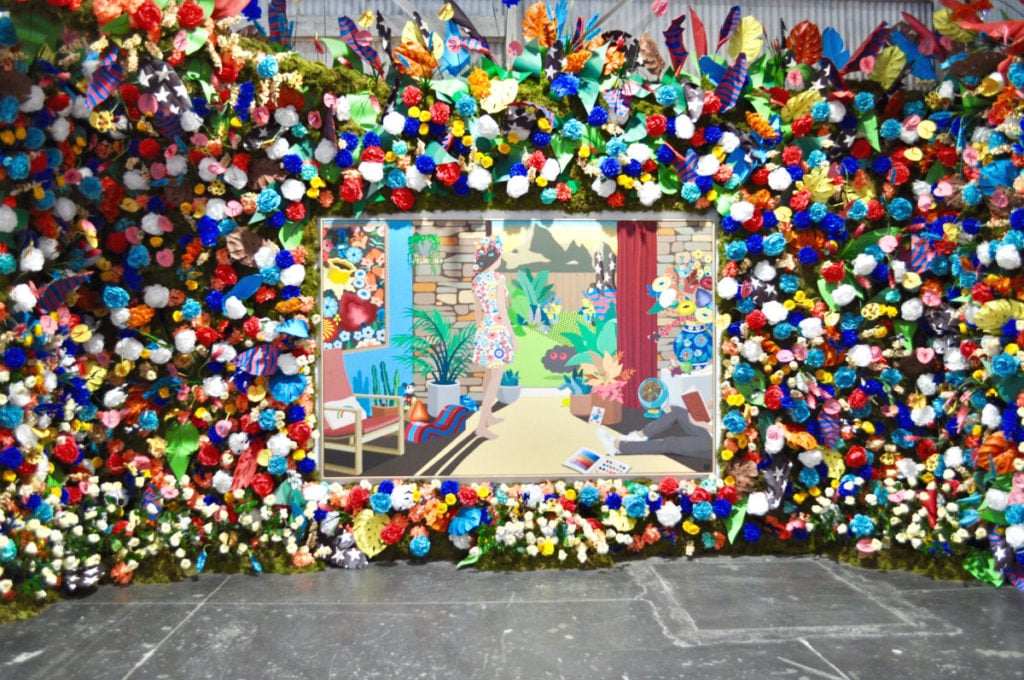
Work by DABSMYLA in “Beyond the Streets.” Photo courtesy Colony Little.
Back inside the warehouse, the Australian duo DABSMYLA created an indoor floral installation, covering a wall with 3,000 paper flowers (courtesy Amelia Posada of Birch and Bone) that frame a trio of large colorful paintings in a whimsical explosion of color.

DABSMYLA, Third Mind (2017). Image courtesy Beyond the Streets.
Together, non-traditional interpretations of graffiti by the likes of Finley and DABSMYLA demonstrate the scope of this art form’s influence on artists whose work goes well beyond it, into the worlds of urban advocacy and floral design, respectively.

Work by Takashi Murakami in “Beyond the Streets.” Photo courtesy Beau Roulette.
Another striking piece in the center of the exhibition is a large spray-painted curtain that’s suspended from the ceiling of the warehouse. Well-known artist Takashi Murakami collaborated with Japanese street artists MADSAKI and snipe1 on this two-sided canvas. It features abstracted renditions of Murakami’s signature characters Kaikai and Kiki painted alongside the colorful bubble writing popularized by 1980s New York graffiti.
On the inside of Murakami’s concave curtain, the writing on the top half of the canvas gives way to molten shapes that are punctuated by orange, red, and yellow hues that make the canvas appear as if it were burning from within. This is Old School Murakami mingling with Old School street art: Murakami became famous for his extensive body of dystopian work referencing anime and Japan’s postwar anxieties about nuclear Armageddon. Here, the raw interpretations of classic New York graffiti also conjure associations with the 1970s economic meltdown that gave birth to graffiti in the Bronx.
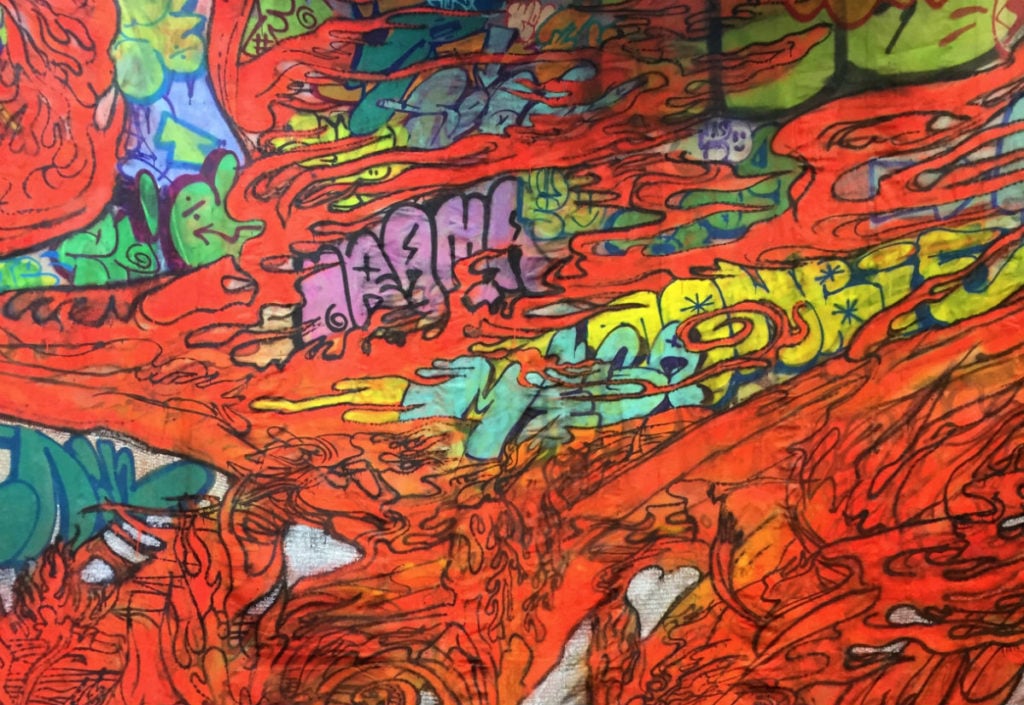
Detail of work by Takashi Murakami in “Beyond the Streets.” Photo courtesy Beau Roulette.
Along one white wall in “Beyond the Streets,” archival photos by graffiti documentarian Martha Cooper provide important historical context, celebrating the graffiti work of artists who are often overshadowed by the commercial success of many of contemporaries celebrated elsewhere here.
In another corner of show, Gastman includes a photographic homage to pioneering graffiti writers Cornbread from Philadelphia, New York’s Taki 183, and Wall Writers of the 1960s and 1970s. Their important lettering styles transformed graffiti from mere tags to murals. As early scribes and respected stewards of graffiti culture, the presence of these original artists’ work, captured in photos and documentary films, extend the ephemeral fame they once found painting walls and trains some 40 years ago.
![Wall Writers [left to right]: Henry 161, Mike 171, Wicked Gary from the Ex Vandals, and SJK 171. Photo courtesy Colony Little.](https://news.artnet.com/app/news-upload/2018/05/wall-writers-1024x680.jpg)
Wall Writers [left to right]: Henry 161, Mike 171, Wicked Gary from the Ex Vandals, and SJK 171. Photo courtesy Colony Little.
“Beyond the Streets” is on view at 1667 North Main Street, Los Angeles, through July 6, 2018.